Inamori Library
4F Social Activities: Exhibition Details
Inamori Foundation
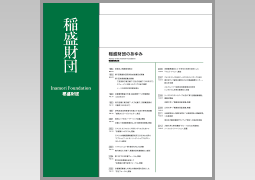
History of the Inamori Foundation
| 1984(Age 52) | The Inamori Foundation was established |
|---|---|
| 1985(Age 53) |
Presentation ceremony for the first Inamori Research Grants The first Kyoto Prize Presentation Ceremony was held in the presence of Prince and Princess Mikasa (through 1992), and Queen Silvia of Sweden A Special Commemorative Kyoto Prize was awarded to the Nobel Foundation |
| 1993(Age 61) | The Kyoto Prize Presentation Ceremony was held in the presence of Prince and Princess Takamado (through 2002) |
| 1997(Age 65) | Established Seiwa Scholars Society, an exchange association for Research Grant recipients |
| 2002(Age 70) |
The Kyoto Prize Symposium was held for the first time in San Diego, California, US Jointly established the Abshire-Inamori Leadership Academy (AILA, US) within the Center for Strategic and International Studies (CSIS, US) |
| 2003(Age 71) |
Princess Takamado accepted the post of Honorary President of the Inamori Foundation The Kyoto International Culture Forum "In Quest of Kokoro / Human Minds for This Planet" held with the Kyoto Prefectural Government and Kyoto University (through 2007) |
| 2004(Age 72) |
Held the first CSIS Kyoto Forum The Kyoto Prize 20th Anniversary Forum was held on the theme, "The Future of Science and Humankind: How can science and technology contribute to human society?" |
| 2005(Age 73) |
Supported establishment of the Inamori International Center for Ethics and Excellence at Case Western Reserve University in Ohio, US, with an endowment from the Inamori Foundation |
| 2007(Age 75) |
Co-sponsored a symposium commemorating German Chancellor Merkel's visit to Japan with the Mainichi Newspapers |
| 2008(Age 76) |
The first Inamori Ethics Prize Ceremony was held at Case Western Reserve University Endowed the Inamori Center to Kyoto University |
| 2009(Age 77) |
Endowed the Inamori Center to Kyushu University |
| 2011(Age 79) |
The Inamori Foundation was formally recognized as a public interest incorporated foundation |
| 2012(Age 80) | Established the Inamori Foundation Endowed Course, "Global Public Ethics and Social Innovation," at Osaka University (through 2016) |
| 2014(Age 82) |
Former U.S. Vice President Al Gore gave a lecture, "To Who Belongs the Blue Planet? - Global Climate and Sustainability of Mankind," to commemorate the Inamori Foundation's 30th anniversary Supported lectures by Kyoto Prize laureates in Kagoshima Held the first Kyoto University-Inamori Foundation Joint Kyoto Prize Symposium (KUIP) |
| 2016(Age 84) |
Special support for the 2016 Hamburg Ballet Japan Tour, in recognition of 2015 Kyoto Prize laureate John Neumeier Sponsored The Matsuyama Ballet's Kyoto Performance of "New Version Swan Lake." (A commemorative event for the Inamori Foundation's 30th anniversary) |
| 2017(Age 85) | Held the first "Kyoto Prize at Oxford," in the UK |
| 2019(Age 87) | Inaugural Children's Science Expo educational event for elementary school students |
Establishment of the Inamori Foundation (1984)
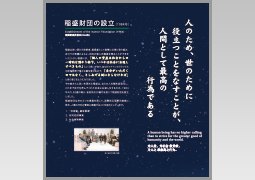
A human being has no higher calling than to strive for the greater good of humanity and the world.
Applying himself earnestly in his work as an engineer and business manager from a young age, Inamori accumulated considerable personal assets as Kyocera grew and developed. However, he believed that "personal assets are held in temporary safekeeping for society, and should at some stage be returned to society." After receiving various awards for fine ceramics research and development, Inamori, who was by now a somewhat wealthy stockholder representing Kyocera, began to feel a bit embarrassed by them. He felt strongly that he should be the one giving awards to others who were dedicating their lives to making advancements in their fields.
As his conviction about this deepened, Inamori took action to put his philosophy into practice and give back to the society which had contributed to his company's success. Therefore, in April of 1984, at the age of 52, he established the Inamori Foundation with about 20 billion yen of his personal assets.
The Inamori Foundation endeavors to advance mutual international understanding and seeks to contribute to peace and prosperity among all people. Specifically, the Foundation operates through the following three activities:
- Presenting the Kyoto Prize
- Research grants
- Social contributions
The Kyoto Prize
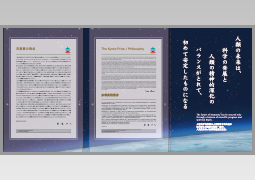
The Kyoto Prize Philosophy
Since I founded Kyocera Corporation in 1959, I have devoted my life as a ceramic engineer to the development of a variety of ceramic materials, such as electronic ceramics, engineering ceramics, and structural ceramics. I believe that this work has contributed significantly to the establishment of our present-day era of fine ceramics.
This year, 1984, marks the twenty-fifth anniversary of Kyocera's founding. After a quarter of a century of relentless and painstaking effort, Kyocera's annual sales have, by the grace of God, grown to 230 billion yen, with pre-tax profits of 53 billion yen(*1). It has been my lifelong belief that a human being has no higher calling than to strive for the greater good of humanity and the world. In keeping with this conviction, I have decided on this occasion to create the Kyoto Prize as a means of recognizing persons who have made outstanding contributions to the progress of science, the advancement of civilization, and the enrichment and elevation of the human spirit. This award will be granted by the Inamori Foundation, which I have endowed with 20 billion yen(*2) in cash and Kyocera stock.
Those worthy of the Kyoto Prize will be people who have, as have we at Kyocera, worked humbly and devotedly, sparing no effort to seek perfection in their chosen professions. They will be individuals who are sensitive to their own human fallibility and who thereby hold a deeply rooted reverence for excellence. Their achievements will have contributed substantially to the cultural, scientific, and spiritual betterment of mankind. Perhaps most importantly, they will be people who have sincerely aspired through the fruits of their labors to bring true happiness to humanity.
I have two major reasons for establishing the Kyoto Prize. First, in keeping with my aforementioned belief that we on Earth have no higher calling than to serve the greater good of humankind and society, I wish in some way to repay the global community that has sustained and nurtured me all these years. Second, I would like to redress the relative lack of formal recognition for highly dedicated but unsung researchers. At the very least, I hope to honor people who have made extraordinary contributions to science, civilization, and spirituality and thereby to motivate them and others like them to reach still greater heights.
I am convinced that the future of humanity can be assured only through a balance of scientific progress and spiritual depth. Though today's technology-based civilization is advancing rapidly, there is a deplorable lag in inquiry into our spiritual nature. I believe that the world is composed of mutual dichotomies--pluses and minuses, such as the yin and the yang or darkness and light. Only through the awareness and nourishment of both sides of these dualisms can we achieve a complete and stable equilibrium. The progression or expansion of any one aspect alone without the other will inevitably upset the natural balance of the universe and contribute to human suffering. It is my sincere hope that the Kyoto Prize may serve to encourage the cultivation of both our scientific and spiritual sides. At the same time, nothing would be more gratifying than if it provided some small impetus for the construction of a new philosophical paradigm.
April 12, 1984 Kazuo Inamori
*1 As per Kyocera's financial results for the fiscal year ended March 31, 1984
*2 As of 1984, at the time of establishment of the Inamori Foundation.
The future of humanity can be assured only when there is a balance between scientific development and the enrichment of the human spirit.
Establishment of the Kyoto Prize
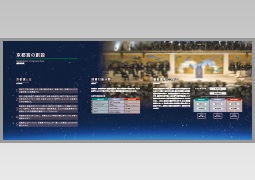
About the Kyoto Prize
- The Kyoto Prize is an international award that celebrates individuals who have contributed significantly to the scientific advancement, cultural development or spiritual betterment of humankind.
- It is presented each year in the three categories of Advanced Technology, Basic Sciences, and Arts and Philosophy. A significant feature of the Kyoto Prize is that it recognizes contributions not just in natural sciences, but in three categories, including arts and philosophy.
- Every year, the Inamori Foundation entrusts the nomination of candidates to third-party Japanese and overseas authorities in each of the categories. Selection of laureates passes through three stages of the Kyoto Prize Selection Organization: a Kyoto Prize Selection Committee, a Kyoto Prize Committee for each category, and finally, the Kyoto Prize Executive Committee.
- Laureates are selected each June, and the presentation ceremony and associated events are held in Kyoto each November.
- Each laureate is presented with a diploma, a Kyoto Prize Medal, and a cash endowment of 100 million yen.
Prize fields
One Kyoto Prize is presented in each of three categories: Advanced Technology, Basic Sciences, and Arts and Philosophy. Each category comprises four fields. Every year, one Kyoto Prize is awarded in one of the four fields in each category.
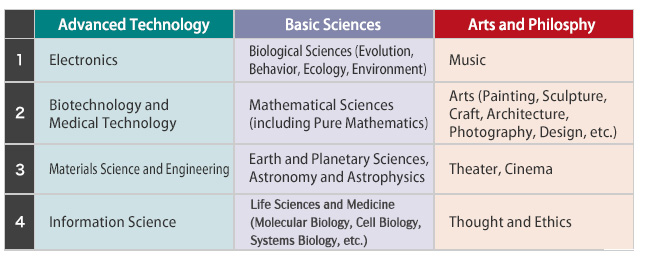
How laureates are selected
Selection for the Kyoto Prize each year begins with the nomination of Kyoto Prize candidates by internationally recognized authorities in each of the Kyoto Prize category fields. These authorities are commissioned for the task by the Inamori Foundation. The Kyoto Prize Selection Organization then reviews the nominations and shortens the list of candidates for review using a wider range of criteria. Additionally, the Kyoto Prize Executive Committee examines the nominations from an overall perspective to determine whether they are consistent with the philosophy of the Kyoto Prize. Finally, the laureates are selected, subject to approval by the Board of Directors.

Related Activities

The Kyoto Prize Presentation Ceremony
The Inamori Foundation invites laureates to a presentation ceremony held on November 10 of each year, amid the autumn colors of Kyoto. The first Kyoto Prize Presentation Ceremony took place in November 1985, the year after the Foundation was established. In commemoration of the first presentation of the Kyoto Prize, the Inamori Foundation awarded a Special Commemorative Prize to the Nobel Foundation. This was in recognition of the immeasurable contribution it had made to the development of culture and science for humanity in the 20th century. The director of the Nobel Foundation and the chairpersons of each of the selection committees came to Japan to accept the Prize on behalf of the Nobel Foundation. In addition, Queen Silvia of the Kingdom of Sweden attended the presentation ceremony in celebration of the Nobel Foundation being awarded the Prize.
Presentation of laureates to the Emperor
For 14 years, from 1990 until 2003, laureates were granted audiences with the Emperor and Empress of Japan at the Imperial Palace.
Kyoto Prize Week
While the laureates are visiting Japan during "Kyoto Prize Week," various events are held both before and after the presentation ceremony. Kyoto Prefecture, Kyoto City and the Inamori Foundation together present a welcome reception on November 9, the day before the ceremony. The presentation ceremony and a banquet are held on November 10. On the 11th, the laureates give Commemorative Lectures to the public, detailing their life philosophies and their perspectives of the world in layperson terms. On November 12, during workshops intended for specialists and researchers, laureates discuss their achievements in their particular fields. Additionally, a Youth Educational Program presents events and workshops tailored for elementary and junior high school youth, high school students and university students.
Overseas Expansion
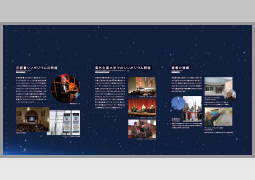
Kyoto Prize Symposium
As president of the University of San Diego, Alice Hayes was deeply impressed when she attended a Kyoto Prize Presentation Ceremony. On her proposal, the San Diego Kyoto Prize Symposium was launched in 2002. Since then, the event has also drawn the participation of San Diego State University, the University of California San Diego, and Point Loma Nazarene University. Co-sponsored by the four institutions, the Kyoto Prize Symposium is held in the early half of each year. Kyoto Prize laureates are invited to give lectures during the symposium, which opens with a charity benefit dinner and gala organized by the local community. Today, the Kyoto Prize Symposium is a major event for the city of San Diego.
Kyoto Prize at Oxford
In 2016, the Inamori Foundation and the University of Oxford, UK, formed a partnership based on a shared sense of values and philosophy. In the following year, the Kyoto Prize at Oxford event was held for the first time at the Blavatnik School of Government, a department of the University of Oxford. In May of each year, laureates of the latest Kyoto Prize are invited to the UK to give public discourses and participate in panel discussions and other intellectually stimulating events held on a grand scale. In the first year of Kyoto Prize at Oxford, as president of the Inamori Foundation, Inamori gave a special talk titled, "From a Society of Greed to a Society of Altruism." Lord Christopher Patten, Chancellor of the University of Oxford, and Inamori unveiled a plaque commemorating the renaming of the Blavatnik School forum as the Inamori Forum.
Chain of goodwill
Regarding use of the monetary prize included in the Kyoto Prize, Inamori stated that he wished to acknowledge the hard work of people who have dedicated their lives to research, and he believed the recipients should use it as they see fit. Many of the laureates have used the prize money to contribute to the education of younger colleagues and the enhancement of research institutes.
- Andrzej Wajda (1987 Arts and Philosophy category)
Mr. Wajda used all of his prize money to set up the Kyoto-Krakow Fund and build a Japanese Fine Arts Center in Poland. - Dr. Daniel Hunt Janzen (1997 Basic Sciences category)
Dr. Janzen used all of his prize money to establish a fund for preservation of tropical forests. - Dr. Isamu Akasaki (2009 Advanced Technology category)
Donated an LED monument "The Blue Drop" to Kyoto Municipal Saikyo Senior High School. He also contributed scholarship funds to Nagoya University and Meijo University, and donated to the Japan Society of Applied Physics and the Japanese Association for Crystal Growth.
Inamori Foundation Activities
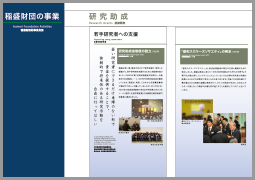
Supporting Young Researchers
In providing funding with minimal obligations to young researchers, I would like them to freely carry out their promising, creative research.
Created the Inamori Grants Program (1985)
Inamori set up this system to support young researchers. He was drawing on his experience from early in his career when he pressed on with research amid a lack of funds. The first Research Grant presentation ceremony was held in 1985. Since then, grants of one million yen each have been given to about 50 people per year. Years ago, Inamori said that he hoped a Kyoto Prize laureate might be chosen from among the grant recipients in the future. His wish came true: Dr. Shinya Yamanaka, the 2010 laureate in the Kyoto Prize Advanced Technology category, was a Research Grant recipient in 2004.
Established the Seiwa Scholars Society (1997)
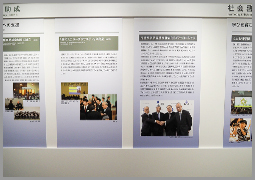
The Seiwa Scholars Society was set up with the aim of providing recipients of the Research Grants with opportunities to get to know and inspire one another. On establishing the Society, Inamori said, "Science and technology today are being increasingly specialized in specific fields. Meanwhile, there are many issues in the greater sphere of science that cannot be resolved unless researchers in their respective fields get together and share their knowledge. I hope the accumulation of ideas and discussions encouraged by such interaction will be a catalyst to spark a new thought, which in turn will become a great energy that builds an increasingly sympathetic resonance throughout all fields of science."
Inamori Research Institute for Science (InaRIS) Fellowship (2019)
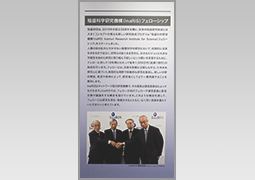
On its 35th anniversary in 2019, the Inamori Foundation launched the Inamori Research Institute for Science (InaRIS) Fellowship, a new research grant program with a concept distinct from the traditional Inamori Research Grants.
Focusing on the realm of basic scientific research, which is indispensable to the expansion of human knowledge, this fellowship enables researchers to pursue highly ambitious and promising work driven by curiosity, rather than short-term results, by providing an annual grant of 10 million yen for 10 years (totaling 100 million yen). Fellows are expected to advance their pioneering research with a long-term vision, and to leap further as researchers by exploring new fields while making new discoveries and inventions, propelled by their unwavering curiosity.
InaRIS operates as a network-based research institution governed by a steering committee. It provides opportunities for fellows to exchange opinions and engage in discussions with other fellows and committee members. Through such exchanges, InaRIS fellows deepen their research and acquire new and broader insights in a wide range of disciplines.
Nurturing the Joy of Learning
Children's Science Expo (2019)
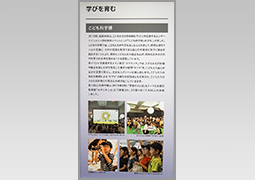
In 2019, the Inamori Foundation initiated the Children's Science Expo, an entertainment-based educational event to support children's innate desire to learn. The expo aims to expand childhood pathways to learning through educational activities designed to be fun. Participants observe the wonders that fill our world and discover their potential to unravel the mysteries of nature, igniting a passion for scientific inquiry at an early age.
The main exhibit symbolizing this event is the Kizuki Tree, which projects children's "kizuki" (realizations or discoveries) onto a large screen, articulating their insights and questions during the expo. These genuine expressions of curiosity are shared among attendees, triggering higher levels of curiosity and exploration.
"Mysteries of the Universe" served as the theme of the inaugural Children's Science Expo, which was held in August 2019 at the Kyoto International Exhibition Hall (Miyako Messe), attracting around 12,800 visitors over two days.
The Kyoto University-Inamori Foundation Joint Kyoto Prize Symposium (2013)

In 2013, the Inamori Foundation and Kyoto University signed a memorandum for the Kyoto University-Inamori Foundation Joint Kyoto Prize Symposium (KUIP). The KUIP aims to stimulate researchers and artists worldwide by broadening understanding of the Kyoto Prize and promoting the advancement of science, technology, and arts. It is hosted, planned, and operated by Kyoto University, with the Inamori Foundation as a co-host. The inaugural symposium was held at Kyoto University in 2014 and has since been open to experts, students and the general public. At its 5th iteration in 2018, the venue moved to Tokyo, and the symposium now invites Kyoto Prize laureates to participate. Beyond showcasing cutting-edge trends in research, academia, and the arts, the KUIP offers a platform for exchanges between researchers, both within and across disciplines, contributing to the novel progression of knowledge.
The Inamori Ethics Prize
Sponsored by Case Western Reserve University, the Inamori Ethics Prize was founded on an endowment from the Inamori Foundation. The Prize is presented to individuals who have shown exemplary ethical leadership and contributed substantially to the betterment of human society through their research and activities relating to ethics.
Quest for Ethics
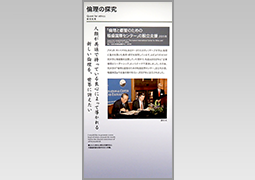
I would like to promote a new kind of ethics around the world, led by the shared conscience of all humankind.
Supported establishment of "The Inamori International Center for Ethics and Excellence" in the U.S. (2005)
Case Western Reserve University in Ohio, US, developed an education and research program with an emphasis on ethics. Kyocera had previously endowed a professorship at the university, and in 2002, Inamori gave a lecture titled, "Ethics and Leadership from a Global Perspective." Later, assisted by a donation from the Inamori Foundation, the university built the Inamori International Center for Ethics and Excellence, which opened in 2007.
Educational Support
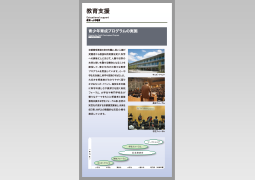
Created the Youth Development Program
During Kyoto Prize week, when Kyoto Prize laureates are in Japan, the Inamori Foundation conducts a diversified educational program tailored for youth. In addition to enabling young people to receive intellectual inspiration directly from the laureates, it is hoped the program intends to provide students with an opportunity to look beyond the sciences and think deeply about human society and the future of our world. For example, during the Kids' Event, laureates talk with elementary and junior high school students about the wonders and importance of science and the arts. The High School Forum focuses on explaining the enjoyment and depths of science to high school students. Meanwhile, university and vocational school students participating in the Student Forum can exchange views directly with the laureates on all manner of topics. These and other events in the program are offered as opportunities for dynamic exchange between the wise, experienced Kyoto Prize laureates and younger generations who will be responsible for guiding our world in the future.
University Support
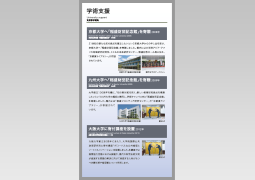
Endowed the Inamori Center at Kyoto University (2008)
The Inamori Foundation endowed the Inamori Center to Kyoto University in response to the university's request for help in establishing a new focal point of knowledge for the 21st century. The Center has various departments, including the Graduate School of Asian and African Area Studies, the Kokoro Research Center, the Inamori Foundation Memorial Hall, and the Kyoto Prize Library.
Endowed the Inamori Center at Kyushu University (2009)
To mark its 100th anniversary, Kyushu University aimed to set up a new hub of creative academic research for the 21st century, one that would guide regional and international society while cultivating leaders to shape a bright future for humankind. The Inamori Foundation concurred with this goal and endowed the Inamori Center. Located on the Ito Campus, the Inamori Center includes the Inamori Frontier Research Center and the Kyoto Prize Library.
Founded the Inamori Endowment Lecture at Osaka University (2012)
On the 80th anniversary of Osaka University, the Inamori Foundation established an endowed course, "Global Public Ethics and Social Innovation," at the university's Osaka School of International Public Policy. This course examines the sense of responsibility and ethics needed by people who aim to resolve international issues resulting from the complex problems confronting our modern civilization.
Seiwajyuku
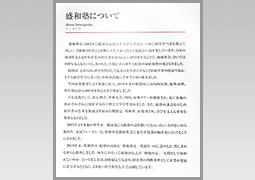
About Seiwajyuku
Seiwajyuku is an independent study group formed in 1983 in response to requests from young managers in Kyoto seeking to learn the art of management from Kyocera founder Kazuo Inamori. Based on the conviction that better leadership can help small- to medium-sized businesses contribute to the local and national economy, this group served as a platform for serious students of management to work diligently with Inamori.
Inamori led Seiwajyuku without compensation based on his philosophy, which regards helping employees refine their character and attain happiness as part of a leader's responsibilities. Seiwajyuku spread throughout Japan, reaching 56 chapters domestically and 48 overseas, with approximately 15,000 members, upon the conclusion of its operations in 2019.
Its main activities included regular meetings hosted by Inamori personally, global conferences, and tours both within Japan and overseas. Individual branches held their own regular meetings to deepen their study and understanding of Inamori's philosophy. In addition, the organization published Seiwajyuku Journal, featuring lectures by Inamori and personal accounts of members' experiences, which became an essential teaching material to enhance the learning experience.
Starting in 2003, a "Civic Forum" was launched by students from multiple areas who wanted community residents to hear Inamori's teachings, further expanding Seiwajyuku's contribution to society.
At the end of 2019, Seiwajyuku's organization was dissolved and its activities concluded in response to Inamori's advancing age and his conviction that the group should operate for a single generation. The spirit of altruism and contemplation of what is right as a human being, which Inamori taught for 36 years, spread across nations and contributed to the development of many businesses by providing managers with a universal decision-making standard and a vision of a better world.
The birth of Seiwajyuku
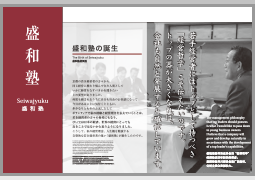
I received a request from young business owners in Kyoto asking me, as a person who has also struggled while managing a business, to talk to them about how they should conduct their businesses. Having received repeated requests, I came to realize that I owe what I am today to the support of society. I thought that voluntarily passing down my experiences and management rationale in return might help those young business owners - even if only a little - which would eventually contribute to the good of the Japanese economy as well as the world. This is how "Seiwajyuku" was born, a place where young business owners come together voluntarily to learn about my management rationale and life philosophy.
The management philosophy that top leaders should possess is what I would like to pass down to young business owners. I believe that a company will grow and develop naturally in accordance with the development of a top leader's capabilities.
Seiwajyuku ― Prospectus for Nationwide Organization
Regardless of a company's size, people involved in corporate management exert all-out efforts day after day to ensure the stable development of the entire enterprise, including its employees. I think it is quite reasonable that once we establish a firm or take over a business, as the company's top leaders, we bend over backward day and night without a moment's respite, driven by anxiety and frustration. All the while, we imagine the misery that everyone in the company ― including those of us in management ― might suffer if we make even a single mistake.
Especially now, as we enter the 1990s, the Japanese and global economies that were steadily developing in the 45 years since the end of World War II have entered a period of dramatic structural change. As the world plunges into an era of turmoil and upheaval with the end of the century approaching, business owners should brace themselves for even more challenging times.
After graduating from university, I worked as a ceramics researcher for four years. Then, 32 years ago, Kyocera was established with 28 staff members. Since that time, I have dedicated myself, heart and soul, to managing the business. Today, Kyocera Group companies have grown to employ as many as 26,000 people in Japan and overseas and produce annual gross sales of 500 billion yen. Among these companies, Daini Denden, Inc., which is in the telecommunications sector, has 1,500 employees and annual sales of 150 billion yen.
From the time I established Kyocera, I felt that corporate operations were influenced considerably by the philosophy, mindset, rationale and convictions of top management. Therefore, I have endeavored to refine my character, elevate my mind, and improve my philosophy as a manager. Today, I have reached the conclusion that everything ― including business operations and the course of our lives ― is determined by a person's state of mind. When I reflect on my own experiences, I am certain this is true.
Seven or eight years ago, I received requests from young business owners in Kyoto who wanted to hear my ideas as one who has been involved in management and gone through struggles similar to theirs. They wanted to hear my thoughts about how a manager should operate a business. I was asked about this multiple times, and I realized that what I am today is due to the support I received from the local Kyoto community. I began to think that by voluntarily passing on my experiences and management philosophy, I might be able to give something back. It might prove useful to young business leaders and, eventually, help the Japanese and global economies as well.
Thus, Seiwajyuku began in Kyoto as an impromptu gathering of young business owners who wished to study my management rationale and outlook on life. Some of the people who participated in those meetings independently set up Jyuku branches. We now have seven Seiwajyuku schools ― in Kyoto, Osaka, Kobe, Shiga, Kagoshima, Toyama and Tokyo.
It has been a great pleasure to witness young participants who listened attentively to my talks and absorbed ideas like sponges, put them into practice, and achieved tremendous results in their management. Recently, though, there have been requests from many participants saying that, as happy as they are to be studying with me in person, there are many more young business owners across Japan that they want me to talk to so that they, too, could become excellent business owners.
I'm just one person, and I have time constraints. However, although I will turn 60 next year, with the encouragement of Seiwajyuku members, I decided to establish a nationwide Seiwajyuku organization for up to 5,000 young business owners. By giving my best efforts to convey my management rationale and outlook on life, I hope to help elevate the character and mindset of many young business owners. I further hope, as a result, I might be of use in fostering a level of management that will enable their companies to prosper, and to bring peace and growth, not only for employees but also for all human beings and the world.
As I said earlier, the heart of the manager is the key to business management. Learn the essence of management. If the heart of the manager changes, the business will follow without fail. Elevate your natural virtues and aspire for corporate stability and prosperity. It is my earnest desire to be joined by people who wish to advance in this direction.
Kazuo Inamori
Jyukucho (Principal), Seiwajyuku
January 1991
Expansion of Seiwajyuku
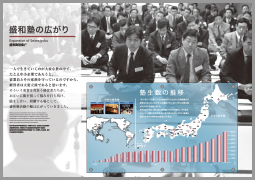
Business owners are admirable. Even if they are running small or medium-sized businesses, they work to protect their employees and their families in a world where it is difficult to make it on their own. Seiwajyuku's activities expanded to provide opportunities for business owners, who assume such a heavy burden, to share their problems openly, encourage one another and study together.
Seiwajyuku Members ― Growth trends
In 1991, Seiwajyuku embarked on a plan to create a nationwide organization with "100 Branches / 5,000 Members." In 2018, there were 100 branches and membership reached 13,610. Outside of Japan, Seiwajyuku Brazil opened in 1993. After that, Seiwajyuku opened branches in the US, China, and other places all over the world, transcending national borders to cultivate the next generation of business owners.
Regular Study Sessions with Inamori
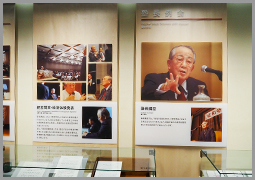
Inamori's Lecture
In Jyukucho Lectures, Inamori talks about the management philosophy he developed through his personal management experiences. Each lecture focuses on a particular question. For example, "What is the purpose of a company?" or "What is the right attitude for a manager?"
Q&A on Management / Presentation on Management Experience
A Jyukucho Lecture was accompanied by a management guidance session known as Q&A on Management. Jyuku members gave detailed accounts of acute problems they faced in management, after which Inamori applied his wisdom and experience to identify solutions.
Additionally, in Presentation on Management Experience, members talked about their personal experiences in management and the lessons they learned in the process. Members in the lecture audience benefited by listening to both the speakers' experiences and Inamori's comments.
Seiwajyuku World Convention / Independent Study Session
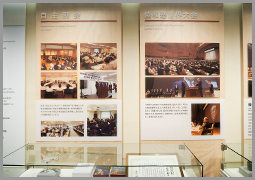
Seiwajyuku World Convention
The first Seiwajyuku National Convention was held in 1992. In 2011, the name changed to Seiwajyuku World Convention. A large number of Seiwajyuku members, who had a sincere desire to learn about management, participated--both from overseas and throughout Japan. The two-day, annual conference was full of enthusiasm and promoted a sense of unity.
Independent Study Session
Each Jyuku branch held its own study sessions, in which members worked together on improving and refining their abilities. Members gave presentations about their management experiences, read together through particular sections of Inamori Jyukucho's publications, watched video lectures, and conducted workshops tailored to their particular Seiwajyuku branch.
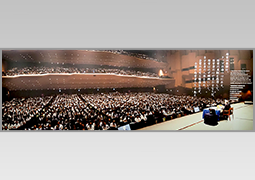
"The essence of management lies in the minds of top executives.
If you learn the fundamentals of management and change your mindset, business will run smoothly for sure.
Gather here, business owners who wish to heighten your virtue and increase the stability and prosperity of your company!"
History of Seiwajyuku
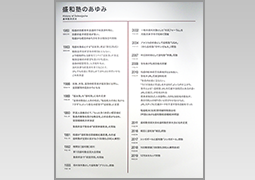
| 1980(Age 48) | Inamori gave a talk to the Kyoto Junior Chamber of Commerce and Industry. This led to a study group in which young business owners in Kyoto gathered around Inamori to learn his thoughts about management |
|---|---|
| 1983(Age 51) |
The founding of Seiyujyuku, with Inamori as jyukucho (principal), and 25 initial members. Seiyu referred to Inamori's friends, and jyuku a private school. |
| 1986(Age 54) | Business owners from Hyogo, Osaka and Shiga prefectures began attending the Seiyujyuku -- the group's first step toward nationwide expansion |
| 1989(Age 57) |
The name of the study group was changed from Seiyujyuku to Seiwajyuku |
| 1990(Age 58) |
The Seiwajyuku Board decided to turn Seiwajyuku into a national organization |
| 1991(Age 59) |
Inamori prepared a "Seiwajyuku Nationwide Organization Prospectus," which planned for the group to expand across Japan in 100 branches, anticipating 5,000 members. |
| 1992(Age 60) |
First issue of the periodical publication, Seiwajyuku Journal |
| 1993(Age 61) | Seiwajyuku Brazil opened, becoming the first Seiwajyuku branch outside of Japan |
| 2002(Age 70) | Held the first Civic Forum for the public, in Yonago City, Tottori Prefecture |
| 2003(Age 71) | The national Seiwajyuku Board adopted a policy to actively grow Seiwajyuku membership |
| 2004(Age 72) | Opened Seiwajyuku USA (now Seiwajyuku Los Angeles), the first branch in the United States |
| 2007(Age 75) | Opened Seiwajyuku Wuxi, the first branch in China |
| 2008(Age 76) | The number of Seiwajyuku members surpassed 5,000 |
| 2010(Age 78) |
In conjunction with Inamori's appointment as chairman of Japan Airlines, Seiwajyuku members formed the "JAL Cheering Squad." Established a Seiwajyuku umbrella organization in China |
| 2011(Age 79) | Changed the name Seiwajyuku National Convention to Seiwajyuku World Convention |
| 2012(Age 80) | The number of Seiwajyuku members surpassed 8,000 |
| 2015(Age 83) |
The number of Seiwajyuku members surpassed 10,000 |
| 2016(Age 84) | Opened Seiwajyuku Korea, the first branch in South Korea |
| 2017(Age 85) | Opened Seiwajyuku Singapore, the first branch in Singapore |
| 2018(Age 86) | The number of branches reached 100, with 5,000 members, as the prospectus envisioned. |
| 2019(Age 87) |
The decision was made to close down Seiwajyuku at the end of 2019 |
Diverse Social Activities
Human Resources Development and Academic Support
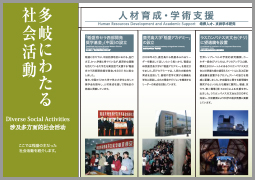
Establishing the Inamori-Kyocera Western Districts Development Scholarship Fund (China)
In 2001, Inamori and Kyocera set up the Inamori-Kyocera Western Development Scholarship Fund in the western provinces of China. The Fund provides financial support to economically disadvantaged university students who show strong moral character and outstanding academic achievement. Scholarships are granted each year to selected students studying at one of twelve universities in China. The Fund contributes to the development of western provinces by nurturing future leaders.
Established the Inamori Academy at Kagoshima University
Wishing to support the development of passionate leaders in Kagoshima, in April 2008, Inamori established the Inamori Academy at his alma mater, Kagoshima University. With a focus on producing well-rounded graduates, the Academy provides students with lectures on ethics and philosophy. The Academy aims to create leaders who will steadfastly pursue their ideals and visions.
"Inamori Memorial Hall" a liberal arts facility supporting collaboration between three Kyoto universities
Kyoto Prefecture envisioned a combined educational institute involving Kyoto Prefectural University of Medicine, Kyoto Prefectural University, and the national Kyoto Institute of Technology. Inamori concurred with the project's goals and gave his support. He noted that there is great significance in broad cultivation of the humanity of young students at the three universities and in encouraging mutual exchange between them. Completed in September 2014, the Center for Collaboration in Liberal Arts Education was named Inamori Memorial Hall. The institute has 17 classrooms, laboratories, independent study rooms, a café and other facilities. Additionally, the Inamori Memorial Display Room introduces Inamori's path in life and way of thinking, and is open to the public.
Inamori donated 1 million shares of Kyocera stock to Kagoshima University
In 2017, Inamori donated one million shares of Kyocera stock from his personal holdings to Kagoshima University. A formal acceptance ceremony was held at the university in November of that year. During the ceremony, Inamori said he hoped the donation would be put to good use both for the teachers and students with future promise at Kagoshima University, the school that helped him get a good start on his path in life. Using the shares, the university set up a fund to support, programs that include overseas studies by students and the cultivation of researchers.
Social Activities
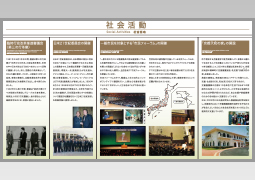
Held the Japan-US 21st Century Committee Meetings
This committee was formed to discuss the ideal current and future state of Japanese-American relations. Notable names on the Japanese side included former Prime Minister Kiichi Miyazawa (chairman emeritus) and the writer, economist and former bureaucrat, Taichi Sakaiya (chairman). Notable representatives on the US side included former President George H. W. Bush (chairman emeritus) and former US Trade Representative William E. Brock (chairman). The committee met four times over two years, from June 1996 to May 1998. Twenty-five experts and authorities representing Japan and the US engaged in constructive debate on the roles that should be taken by the two countries should undertake and finally sent the "Japan-US Declaration for the 21st Century" to the heads of state of both Japan and the US.
Held Civic Forums for general public
Seiwajyuku members said they wanted the public to have the opportunity to hear Inamori Jyukucho speak in person. Inamori concurred with the idea, commenting, "If I can help to make a better society, I will do so" and voluntarily presented lectures in Civic Forums held all over the country. In the lectures, Inamori talked about the purpose of life, explaining that we can lead a wonderful life by continually working to refine our spirit.
Seiwajyuku, with branches all over the world, sponsored the Civic Forums, mainly in Japan, but also in the US and Brazil. By December 2016, 59 Civic Forums had been held, attended by over 100,000 people. Feedback showed that many participants across all ages and genders were deeply impressed by the experience.
Established the Kyoto Daiwa Children's Home
The rising incidence of child abuse and neglect means many children are unable to live as part of a family. In 2004, Inamori used personal assets to build a facility where infants and children can live and grow in comfort and safety. The facility, named Kyoto Daiwa Children's Home, is located in Seika-cho, in the southern part of Kyoto Prefecture. Designed in the light and cheery style of southern Europe, the home accommodates up to 60 younger and older children, plus 20 infants. The children's section is divided into six household lifestyle units for up to 10 children in each. Children of elementary and junior high school age receive private tutoring five days a week. The home provides full support so that children can become self-reliant and perhaps eventually return to their family units. Additionally, the Inamori Social Welfare Foundation, established in 2003, provides economic support to help young adults become independent members of society when they leave children's homes in Kyoto Prefecture.
Regional Contribution
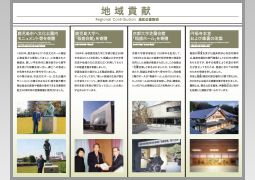
Made numerous donations to Kagoshima City, including contribution for Culture Park monuments
In 1980, Inamori received a request for financial assistance from Kagoshima City to build a Civic Culture Hall. Inamori remembered well the scholarship he received from Kagoshima City when he was a poor student and did not hesitate to return the favor to his hometown. In addition to building a monument within the Culture Park of the Civic Culture Hall, the donation was used to establish a social welfare fund for Kagoshima City and to purchase books for his alma mater, Gyokuryu Senior High School, on the school's 40th anniversary.
Endowed the Inamori Hall at Kagoshima University
In 1994, Inamori endowed the Inamori Academy to his alma mater, Kagoshima University, commemorating the 50th anniversary of the university's Faculty of Engineering. The purpose of the Academy is to facilitate academic exchange and broad cultural interaction with the local community. Designed by noted Japanese architect Tadao Ando, the oval-shaped hall reflects "an image of a microcosm filled with the life force of new creation, and the wish to see Kagoshima produce young people who will reach out into the world and take responsibility for the next era."
Endowed the Shiran Inamori Hall at Kyoto University
Shirankaikan is a facility built in 1999 to commemorate the 100th anniversary of the Kyoto University Faculty of Medicine. Its purpose is to support collaboration with society and enhance medical education. Inamori donated funds to Kyoto University for the facility's construction, and in recognition, the second-floor auditorium was named Inamori Hall. The auditorium holds 250 people and is often used for academic society conferences, lectures, symposia and other events.
Donated to renovation of Empukuji Buddhist temple's main hall and priests' quarters
Inamori entered the Buddhist priesthood at Empukuji, a temple in the Myoshinji school of the Rinzai sect. Empukuji has a 220-year history and was the first dedicated Buddhist training temple in the Rinzai sect. Many years of use and weather had taken a toll on the temple's main hall, and Inamori and Kyocera offered to contribute toward renovating it. The main hall and the priests' living quarters were rebuilt, and a grand ritual to celebrate completion was held in 2003. The renowned Japanese-style painter, Shiko Ito, was commissioned to paint the partitions in the Shoin (study).